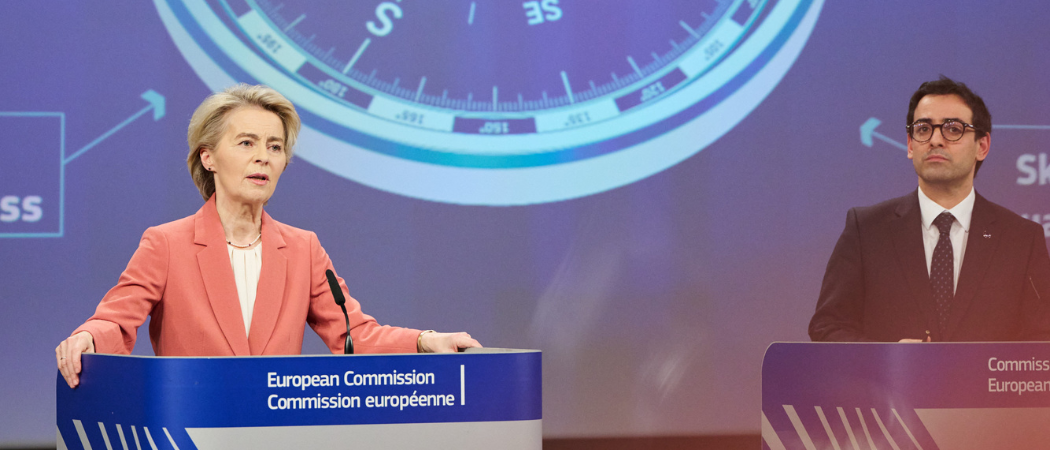A new leaked plan for the EU Competitiveness Fund adds further uncertainty, as commissioners gather to discuss the next multiannual budget

Ursula von der Leyen, President of the European Commission, and Stéphane Séjourné, Executive Vice-President of the European Commission, presenting the European Competitiveness Compass. Photo credits: Dati Bendo / European Union
EU research and innovation policy wonks are fretting over a new leaked chart detailing the structure of the proposed European Competitiveness Fund, which appears to be designed to bring several EU funding programmes – Horizon Europe’s successor included – under a new governance structure.
The structure is described in a presentation slide leaked to lobbyists and media on May 13. According to the presentation, the European Commission is planning to create five pillars inside the Competitiveness Fund: digitalisation; resilience, defence and space; clean transition and decarbonisation; health and biotechnology; and blue-sky research and careers.
Horizon Europe clusters appear to be scattered across these five pillars and bundled together with other existing programmes: Digital Europe, the Connecting Europe Facility, the European Defence Fund, EU4Health, the LIFE programme and others. The European Research Council, which is the EU’s flagship research funding body, is also bundled in the fifth pillar of the planned structure.
The governance structure presented in the leaked memo remains unclear, but does mention “chairs” and “vice-chairs” for each of the five pillars, along with “fund managers” and “steering boards”.
The presentation was seen by Science|Business less than 24 hours ahead of the Commission’s first high-level meeting on the next Multiannual Financial Framework (MFF) due to start in 2028. The Commission is expected to present its MFF proposal in July, with the proposal for FP10 typically following it.
The slide started circulating a day after the Commission’s executive vice-president for prosperity and industrial strategy, Stéphane Séjourné, announced that the Competitiveness Fund may also include research and innovation. Speaking at a conference organised by the Commission to discuss the main ideas underpinning the future fund, Séjourné described it as a “new, coherent architecture which follows the entire life of companies from research to industrial production.”
Science|Business has reached out to the European Commission to confirm whether the leaked chart is indeed part of its preliminary plans for the Competitiveness Fund, but several spokespeople declined to comment. It is the Commission’s official communication policy not to respond to media requests referring to leaks and rumours.
It’s unclear if the slide represents the true intentions of the Commission, but one EU diplomat told Science|Business that the chart “contains ideas” that have been prepared in the context of the Competitiveness Fund. A senior research policy expert said the leaked presentation “seems familiar” and consistent with plans previously floated by the Commission’s budget directorate-general.
One official from the Commission’s directorate-general for research and innovation (RTD) referred to a “total blackout” when it comes to information on the structure of the next MFF and the Competitiveness Fund. However, later in the day on Tuesday, another RTD staff member confirmed the leaked memo had been seen by some in their teams.
Meanwhile, an advisor to an EU member state government called for “caution” as “things are still open” for debate.
FP10 vs Competitiveness Fund
The rumours started when an internal Commission memo dated September 2024 was leaked to lobbyists and journalists in Brussels. The document revealed a scenario in which FP10 would be dismembered and its research and innovation schemes merged into the European Competitiveness Fund. The absence of FP10 from the European Commission’s Competitiveness Compass strategy has only fuelled such fears.
After months of speculation, Ekaterina Zaharieva, the EU commissioner for start-ups, research and innovation, added to the confusion by saying that “we can have both” a Competitiveness Fund and a standalone FP10.
However, the European Parliament, the Council of the EU, and the wider research community are endorsing a "self-standing" FP10. In particular, the Parliament took a firm stance on the independence of FP10 in two plenary votes on a report presented by the research and industry committee and another one presented by the budget committee.
Eszter Lakos, a member of the European Parliament’s research and industry committee, voiced strong concern over the proposed structure outlined in the leaked chart.
“The most pressing concerns relate to the unclear governance structure and the absence of critical programme components, including research infrastructures, the Marie Skłodowska-Curie Actions, the European Institute of Innovation and Technology and the Widening participation dimension,” Lakos told Science|Business, adding that the autonomy of the European Research Council also appears to be under threat.
Editor’s note: this story has been updated with comments from MEP Eszter Lakos.





 A unique international forum for public research organisations and companies to connect their external engagement with strategic interests around their R&D system.
A unique international forum for public research organisations and companies to connect their external engagement with strategic interests around their R&D system.